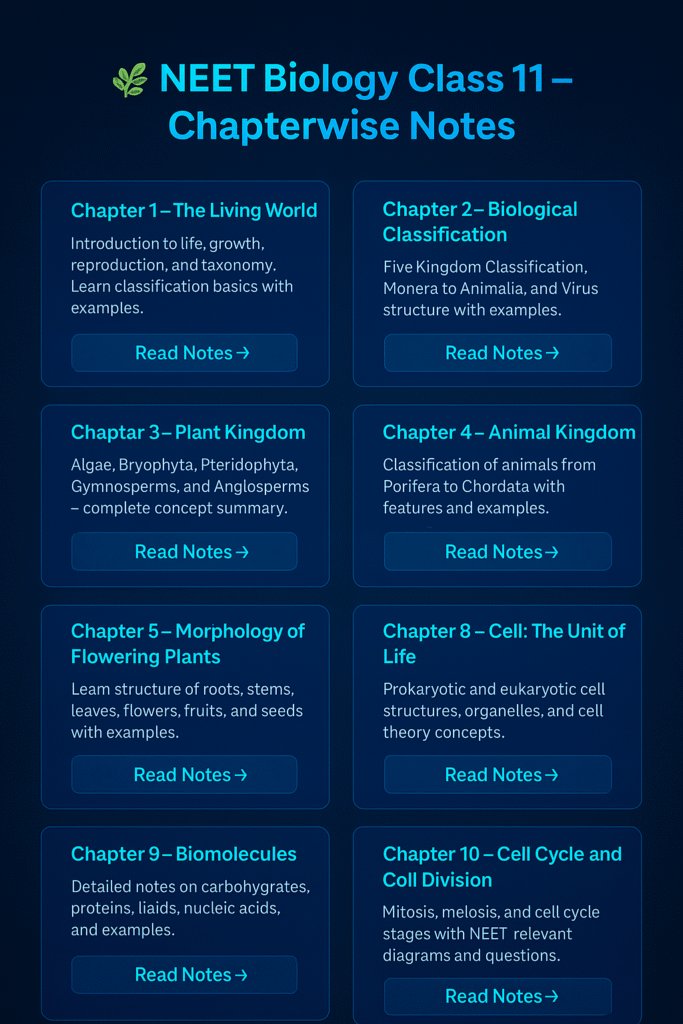🧬 NEET Biology Class 11 Notes Important Topics
Chapter 1 – The Living World
Biology is the science of life. Organisms show growth, reproduction, metabolism, and response to stimuli.
- Metabolism: Sum of all biochemical reactions in a living cell.
- Taxonomy: Science of naming and classifying organisms.
- Binomial Nomenclature: Proposed by Linnaeus — two names (Genus + Species).
- Hierarchy: Kingdom → Phylum → Class → Order → Family → Genus → Species.
- Taxonomical Aids: Herbarium, Botanical Gardens, Museums, Zoological Parks.
Chapter 2 – Biological Classification
- Whittaker’s Five Kingdoms: Monera, Protista, Fungi, Plantae, Animalia.
- Monera: Prokaryotic (bacteria, cyanobacteria).
- Protista: Unicellular eukaryotes (Amoeba, Euglena).
- Fungi: Heterotrophic, chitin wall, spore reproduction (Yeast, Mushroom).
- Plantae: Multicellular autotrophs with cellulose walls.
- Animalia: Multicellular, no cell wall, heterotrophic.
Chapter 3 – Plant Kingdom
- Major Groups: Algae, Bryophyta, Pteridophyta, Gymnosperms, Angiosperms.
- Algae: Aquatic, photosynthetic (Chlamydomonas, Spirogyra).
- Bryophytes: Require water for fertilization (Mosses).
- Pteridophytes: First vascular plants (Ferns).
- Gymnosperms: Naked seeds (Cycas, Pinus).
- Angiosperms: Flowering plants with double fertilization.
Chapter 4 – Animal Kingdom
- Organisation Levels: Cellular → Tissue → Organ → System.
- Symmetry: Radial (Hydra), Bilateral (Human).
- Phyla Highlights: Porifera, Cnidaria, Platyhelminthes, Annelida, Arthropoda, Mollusca, Echinodermata, Chordata.
Chapter 5 – Morphology of Flowering Plants
- Root: Tap vs Fibrous types and modifications (carrot, beetroot).
- Stem: Support and transport (potato = modified stem).
- Leaf: Photosynthesis and gas exchange (onion = modified leaf).
- Flower: Reproductive structure (Calyx, Corolla, Androecium, Gynoecium).
- Fruit & Seed: Ripened ovary and fertilized ovule.
Chapter 6 – Anatomy of Flowering Plants
- Tissues: Meristematic (Apical, Intercalary, Lateral) and Permanent.
- Xylem: Transports water and minerals.
- Phloem: Transports food throughout plant.
- Secondary Growth: Vascular cambium activity forms annual rings.
Chapter 7 – Structural Organisation in Animals
- Tissues: Epithelial, Connective, Muscular, Nervous.
- Examples: Bone, Cartilage, Ligament, Neuron.
- Animals to Study: Earthworm, Cockroach, Frog.
📘 NEET Biology Class 11 Notes Important Topics
Click any chapter above to read detailed explanations and practice questions on MathScience.in
🌿 NEET Biology Class 11 – Chapterwise Notes
Chapter 1 – The Living World
Introduction to life, growth, reproduction, and taxonomy. Learn classification basics with examples.
Read Notes →Chapter 2 – Biological Classification
Five Kingdom Classification, Monera to Animalia, and Virus structure with examples.
Read Notes →Chapter 3 – Plant Kingdom
Algae, Bryophyta, Pteridophyta, Gymnosperms, and Angiosperms – complete concept summary.
Read Notes →Chapter 4 – Animal Kingdom
Classification of animals from Porifera to Chordata with features and examples.
Read Notes →Chapter 5 – Morphology of Flowering Plants
Learn structure of roots, stems, leaves, flowers, fruits, and seeds with examples.
Read Notes →Chapter 6 – Anatomy of Flowering Plants
Study of plant tissues, vascular bundles, and secondary growth with labeled diagrams.
Read Notes →Chapter 7 – Structural Organisation in Animals
Animal tissues, organs, and body systems explained with examples and NEET-focused facts.
Read Notes →Chapter 8 – Cell: The Unit of Life
Prokaryotic and eukaryotic cell structures, organelles, and cell theory concepts.
Read Notes →Chapter 9 – Biomolecules
Detailed notes on carbohydrates, proteins, lipids, nucleic acids, and enzyme action.
Read Notes →Chapter 10 – Cell Cycle and Cell Division
Mitosis, meiosis, and cell cycle stages with NEET-relevant diagrams and questions.
Read Notes →The NEET Biology syllabus is primarily based on the NCERT Class 11 and 12 Biology textbooks, as prescribed by the National Testing Agency (NTA). For accurate and official study material, students are advised to refer to the NCERT e-books available on the official NCERT website

NEET Biology Class 11 Notes Important Topics
